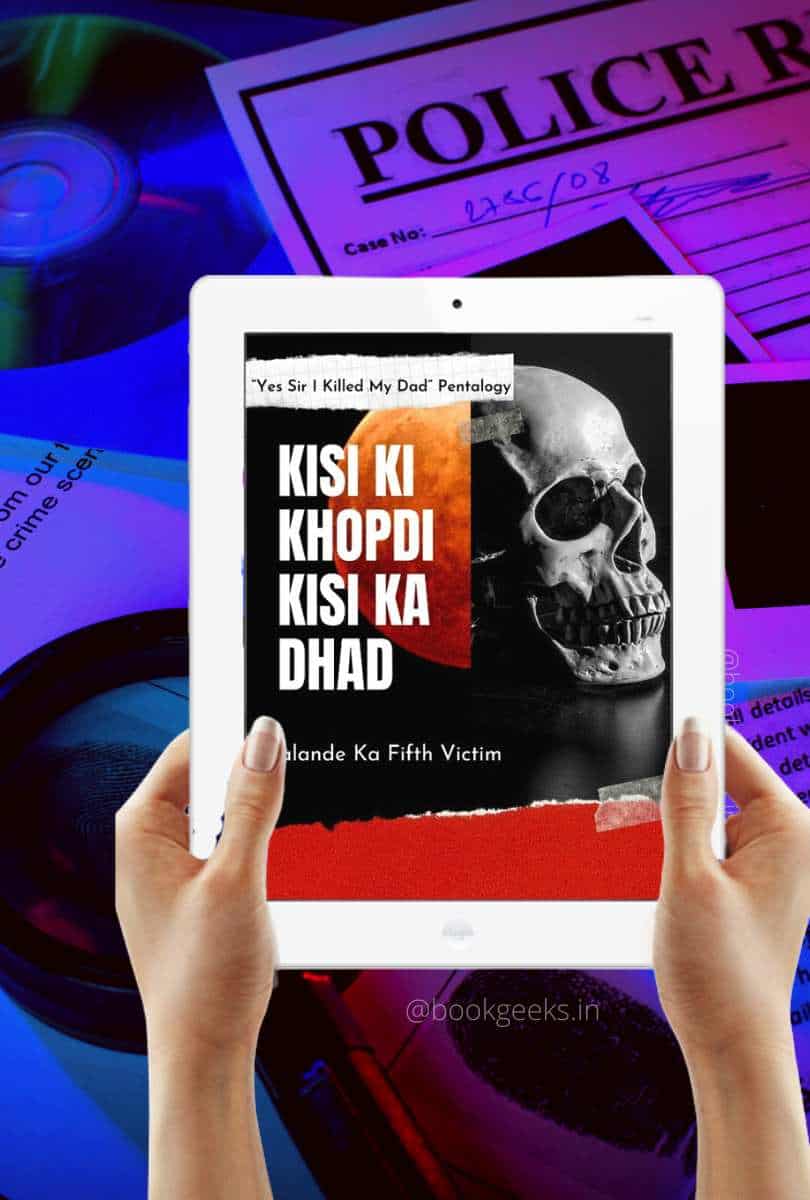SUBJECT: 3.5/5 RESEARCH: 3.5/5 WRITING: 2.5/5 OVERALL: 2.5/5
“How close I came to being the skull in that brown carton in the court, reduced to a DNA report on a sheet of paper. But alas! I am alive and well, breathing, and living so well.”
– Anuj Tikku, Kisi Ki Khopdi Kisi Ka Dhad
Individuals who have been eagerly anticipating the upcoming installment in author Anuj Tikku‘s true crime series no longer have to exercise patience. The author has returned with the most recent addition to the ‘Yes Sir I Killed My Dad‘ series, which originated as a trilogy but has since expanded into a five-part series.
Presenting the fifth book in the series – Kisi Ki Khopdi Kisi Ka Dhad, which delves into another sinister act committed by the serial killer Vijay Palande. Once more, the narrative takes us back to the notorious Kumbharli Ghat, a location renowned for concealing the dark intentions of this cunning criminal mastermind.
For those who remember the preceding volumes, it’s evident that during the exploration of the Kumbharli Ghats region, the lifeless remains and skeletal fragments of another unidentified victim were discovered.
Kisi Ki Khopdi Kisi Ka Dhad is a devoted examination of the case surrounding that anonymous victim – the fifth individual to fall prey to the lethal serial killer, Vijay Palande.
Centering on the retrieval of the skull, skeletal fragments, and upper body segments unearthed at the Kumbharli Ghats, this narrative delves into DNA and blood analysis, along with the sworn accounts of medical professionals and forensic specialists presented in the courtroom.
The account follows the endeavors of the police as they sought to unveil the identity of Vijay Palande’s fifth victim and whether their nefarious activities extended to a broader, concealed range of casualties. Thus, the progression of Case No. 705 – the enigma surrounding the fifth unnamed victim – takes center stage in this book.
Just like his other victims, there was a significant buzz and commotion surrounding the unearthing of a skull deep within the rugged abyss of the Kumbharli Ghats. In conjunction with eighteen skeletal fragments and a substantial portion of an individual’s upper torso, the police force and a team of mountain adventurers stumbled upon a decomposed human skull, which remarkably retained some remnants of ear tissue.
This skull eventually evolved into the enigma of the fifth victim. Although the DNA analysis aligned the upper body with that of Kakkad’s mother, Rita, and brother, Harish, the DNA from the skull told a different tale.
Undoubtedly, Vijay Palande and his cohorts orchestrated a series of horrific murders that left an indelible mark on Mumbai’s history. However, what amplifies the horror is the realization that these sinister acts transpired within opulent skyscrapers, boasting tight security and vigilant safeguards.
The chilling aspect lies in the fact that his targets, belonging to the affluent strata of society, were meticulously chosen; Palande emerged as the embodiment of a serial killer who exclusively preyed on the well-to-do. Driven by grand aspirations, he harbored an insatiable desire to possess what others had.
His approach was methodical: patient observation of his victims spanned considerable time, followed by a gradual and subtle cultivation of trust. Only when he was absolutely certain of their unwavering faith did he execute his deadly intentions.
The malevolent creature can be precisely described using these terror-laden phrases from Anuj Tikku.
“These were not men of this world; they were monsters out for blood with no remorse and no guilt. I had only heard about the underworld in movies and heard stories of killer gangs in novels, not knowing that one day I would become a character in a real-life crime story and a year later would end up being the author of my own true crime story.”
Similar to the majority of entries in the series, this book is concise and straightforward, spanning fewer than 100 pages. The editing and grammar within its pages display a notable enhancement compared to the author’s previous works. This improvement significantly enhances the reader’s overall reading journey.
Once more, Anuj employs his distinctive writing style, blending forthright narratives with a precise infusion of case facts and personal encounters. He adeptly utilizes conversational English, generously seasoned with vernacular Bombaiya Hindi, imbuing the storytelling with an authentic and genuine essence.
Similar to its predecessor, The Trial of Palande, this book offers valuable glimpses into the inner workings of the court and criminal justice system within our nation. It further unveils the disheartening truth about our justice system, where fairness and promptness are frequently absent.
In the end, Kisi Ki Khopdi Kisi Ka Dhad stands as a piece that will resonate with enthusiasts of crime narratives, true crime accounts, and individuals intrigued by legal dramas, courtroom intricacies, and the legal framework.
Can’t wait to read it? Buy Kisi Ki Khopdi Kisi Ka Dhad.
